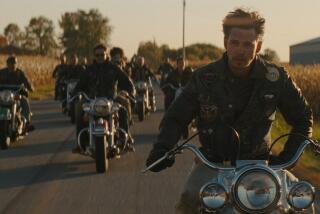When they were at their angriest
It’s counter-intuitive to think you can cobble together a narrative out of anarchy, but filmmaker Paul Rachman manages to pull it off with “American Hardcore,” a documentary exploring the 1980-86 formative years of the American hard-core punk scene spawned primarily in suburban Southern California.
Spinning off Steven Blush’s 2001 book of the same name, Rachman and Blush conducted about 100 interviews with veterans of the scene, telling hard-core punk’s story through their reminiscences. They also persuaded many of the interviewees to dig deep into their closets for old videos of live shows, early interviews and other memorabilia, which Rachman then stitched together in a relatively seamless montage of youthful angst, violence and dark, often disturbing, comedy.
The hard-core scene was deliberately ugly in both tone and style, and the film at times can be a challenge to watch. Not surprisingly, little of the old footage is up to accepted standards, reflecting the do-it-yourself ethos that drove many of the musicians. The documentary might have been improved by leaving the worst of the footage out, but the snippets together capture the rage, exuberance and energy of the time.
And Rachman could have been more generous with captioned identifications. Speakers are named when they first appear but then the viewer has to rely on memory to figure out who comes back later with more anecdotes (Which skinny white guy with a shaved head was that again?).
Still, the documentary is an enlightening journey to a dark corner of contemporary punk’s dank little basement. It also will surprise some to hear how articulately some of the former performers explain the dark impulses that propelled them.
The music was an explosion of misfit frustration that often turned into violent communal flagellation. Rachman begins the film with a self-narrated primer by some of the early musicians, such as Ian MacKaye of Washington, D.C.-based Minor Threat and, later, Fugazi, on how the scene came together.
Early bands like Orange County’s Middle Class and Social Distortion, and L.A.’s Black Flag, emerged in the late 1970s in the wake of the first wave of British punk bands -- the Sex Pistols, the Clash and the Damned.
But the American hard-core bands were at heart a rejection of early punk’s political pretenses. This was music born of emotion, and pain, and although MacKaye and others mention Ronald Reagan’s first presidential election as a catalyst, these kids would have coalesced no matter who was in the White House.
Almost exclusively white and male, they renounced the framing elements of their own lives. It was an all-encompassing refutation of establishments, including the nuclear family and national identity, and particularly of suburbia’s cultural sterility.
Narcissistic in their utter disregard for others, many of the hard-core punks became easy prey for “white power” agitators, and hard core became the soundtrack of hate even as the scene’s most prominent performers disavowed racism.
Still, several of the interviewees -- such as Black Flag frontman Henry Rollins -- speak with nostalgic wonder at crushing elbows into people faces, while others reflect with laughter on trashing houses, concert venues and one another. At times, it sounds like a debriefing of individual members of an unrepentant mob.
Yet at its best, hard core was raw, primal energy -- deep-churned emotions spewed in frenetic motion set to music that often sounded like mistuned engines revving too high. As punker after punker attest in Rachman’s documentary, it was a lot of fun for those within it, and in some cases offered something like a family structure for kids who lost -- or fled -- their own.
But as Mike Ness, frontman for Social Distortion, pointed out in the book (he’s not in the movie), hard-core punkers quickly evolved from being individualists to being conformists. Bands were ostracized for not following the code of loud, fast and indecipherable. The outsiders became insiders and the movement lost its steam.
The best of the early musicians, such as MacKaye, Rollins, and Husker Du’s Bob Mould, matured and moved on, using hard core as a beginning rather than an end. Aficionados -- and the punkers in Rachman’s film -- believe the movement died out around 1986.
But the music, if not the lifestyle, lives on as a cluster of clones, which you can see at just about any high school “battle of the bands” competition. And the mosh pits of today are more of a cliche than anything else, like cellphones held aloft at the Hollywood Bowl.
Just the kind of stuff a hard-core punker would rebel against.
*
‘American Hardcore’
MPAA rating: R for pervasive language including sex and drug references
A Sony Pictures Classics release. Director Paul Rachman. Writer Steven Blush. Inspired by the book “American Hardcore: A Tribal History.” Producers Blush, Rachman. Cinematographer-editor Paul Rachman.
Music supervisor Anthony Countey. Running time: 1 hour, 40 minutes.
Exclusively at Landmark’s NuArt, 11272 Santa Monica Blvd., West L.A. (310) 281-8223; Regal/Edwards University Town Center 6, 4245 Campus Drive, Irvine, (949) 854-8818.
More to Read
Only good movies
Get the Indie Focus newsletter, Mark Olsen's weekly guide to the world of cinema.
You may occasionally receive promotional content from the Los Angeles Times.











